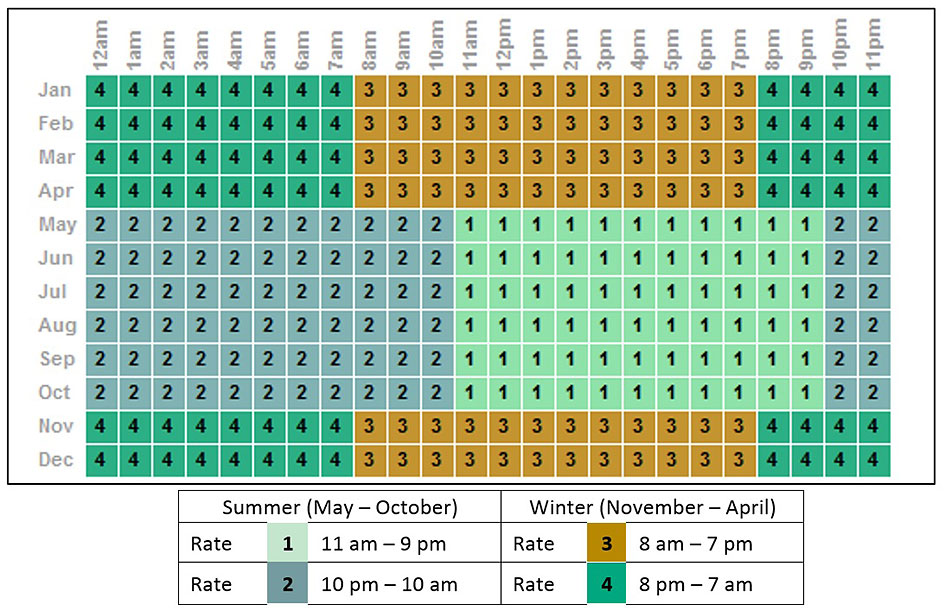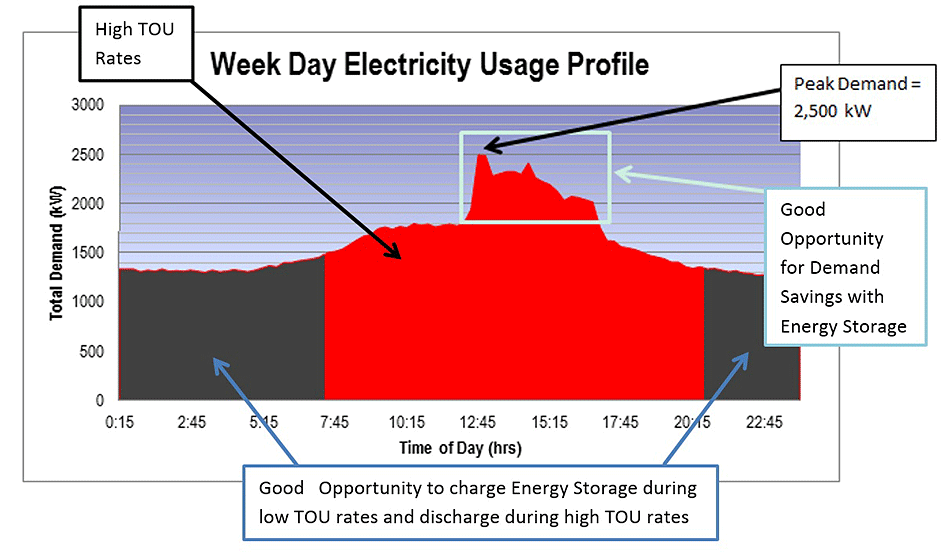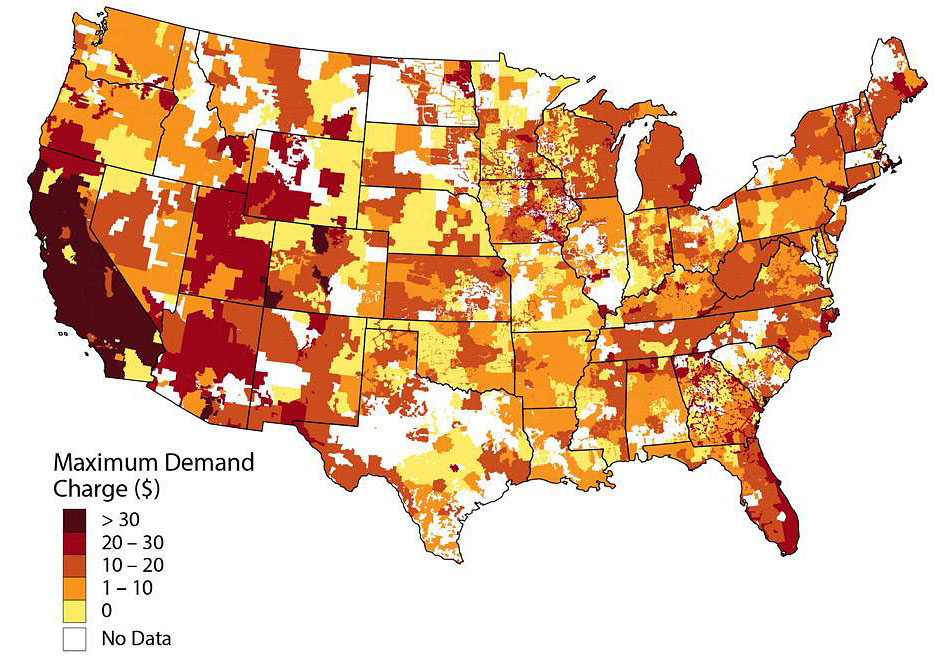When Does Energy Storage Make Sense? It Depends.
Feb. 25, 2018 by Lars Lisell
“It depends” is an engineer’s favorite response to just about every question. But “it depends” is an appropriate response when evaluating whether installing an energy storage system is a good idea. Energy storage can be confusing. The technology adds value to electrical systems by charging when there is excess energy on the system, storing the power until it is required, then discharging when the energy system requires additional energy. Unlike traditional generators that turn fuel into electricity, an energy storage system is used to move energy around. A few common applications for energy storage include moving energy use from a period of high consumption to a period of low consumption, storing renewable generation to be used at night, or storing grid power to be used during periods of grid outage. For an energy storage system to make economic sense, the value of providing this service to a facility or the electrical system must exceed the cost of the energy storage system. How can a consumer determine if an energy storage system makes sense for a facility? The answer often lies in the utility bill.[1]
Utility Bill Charges
There are almost 3,500 electricity providers in the United States,[2] and each one has their own set of tariff sheets, rate structures, and pathways for compensating non-utility-owned energy generation. To assess whether an energy storage system is a good fit for a facility requires a full understanding of utility charges and how they are applied. Common types of utility charges are summarized below:
- Consumption Charge—A consumption charge is the volumetric charge for electricity used during a billing period. The unit of measure is typically the kilowatt-hour (kWh). All customer classes (e.g., commercial, residential, industrial, and municipal) typically pay for consumption. Energy storage does not reduce consumption of energy.
- Demand Charges—Demand charges are the peak rate at which a customer pays for power. The unit of measure is typically the kilowatt (kW). The demand charge for each billing period is often measured in 15-minute intervals, with the highest measured value setting the “peak” for which the customer is billed. Large customers (e.g., commercial, industrial, municipal,) generally always pay demand charges, while small customers (e.g., residential, small commercial) typically do not. Energy storage systems can reduce demand charges by charging when demand at a facility is low and discharging when demand at a facility is “peaking” or is high. This practice is called peak shaving.
- Time of Use (TOU) Charges—In some utility territories, there are different volumetric charges depending on when energy is used. The unit of measure is typically the kWh, but the charge changes for different windows of time throughout the day, week, and year. Energy storage can reduce TOU charges by charging when the energy cost is low (e.g., in the middle of the night) and discharging when the energy cost is high (e.g., late afternoon). As an example, Figure 1 depicts a rate structure with four different TOU rates. There is a nighttime and daytime rate for summer and winter.

All energy storage devices have an efficiency rating for charging and discharging. This is a result of chemical and parasitic losses within the device. The charge and discharge efficiency ratings are combined to calculate a “round trip efficiency” that can be used to quantify the amount of energy that is lost each time an energy storage device is cycled. For energy storage to make economic sense, the cost difference between low TOU rate and the high TOU rate must be large enough to overcome the efficiency loss and operating costs.
The following example outlines a simple calculation that could be performed to determine the difference in TOU rates that would be required for TOU shifting to be feasible with a Li Ion battery:
Battery charging efficiency – 95%
Battery discharging efficiency – 97%
Round Trip Efficiency = 95% x 97% = 92.2%
This means that the difference between TOU rates must be 7.8% or more before any cost savings would be achieved using an energy storage system. If the location under consideration has a TOU utility rate of $0.15/kWh, the low TOU utility rate would need to be less than $0.138/kWh in order to overcome the efficiency losses in the battery.
Favorable Conditions
Energy storage systems work best where demand charges can be reduced by reducing large peaks in electrical demand, and where electrical demand rates are highest. Based on a recent industry analysis, demand charges of $15/kW or higher typically result in favorable economics for energy storage projects. Figure 2 provides an example of an electric usage profile that has both demand charges and TOU rates. In this example, the customer would have opportunities to save on utility costs two ways; by shaving peak demand, and by charging/discharging for TOU savings.

Even in cases where energy storage will not necessarily result in utility bill savings, it may still make sense to move forward with an energy storage system to secure backup power capabilities. Systems that are configured with the proper controls and switches can “island” from the grid and stay energized during a power outage. Although this capability will not reduce utility bills, it has the potential to save money in other ways, including:
- Minimizing or eliminating food spoilage during grid outages
- Reducing equipment damage that can occur during outages
- Keeping lights on so that occupants do not have to leave the building
- Allowing business functions to continue
- Energizing communication systems
- Powering gas pumps to fuel emergency vehicles during natural disasters.
Depending on the type of building and the frequency of power outages, providing backup power could result in a return on investment through avoided outage expenses.
Opportunity
There are many utility customers across the country that could benefit from implementing energy storage at their facilities. This is a market that is still in the early stages of development but is expected to grow substantially over the next five years. Of the nearly 18 million commercial utility customers in the United States, almost 5 million of them are exposed to, or could be exposed to demand charges of $15/kW or higher that would indicate cost-effective opportunities for energy storage (see Figure 3).

Summary
There are a multitude of opportunities to save money by using energy storage systems, but it is imperative to understand the value streams, utility savings, functionality, capabilities, and system costs that are included in the project. By spending time analyzing utility information and knowing what capabilities will benefit a facility, it is possible to determine if energy storage is a good fit in your location.
[1] Utility compensation framework is continuously changing as new rate tariffs are introduced, and the value streams for energy storage are therefore also continually changing. As technology and markets change, energy storage may be able to capture additional compensation beyond what is outlined here.
Share

